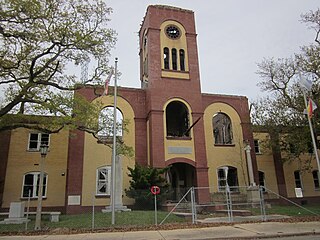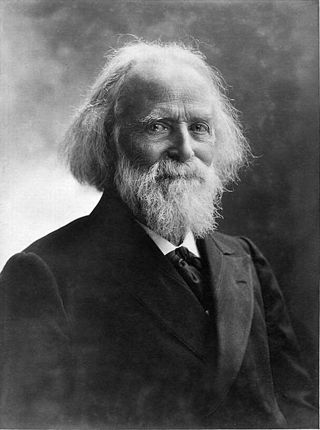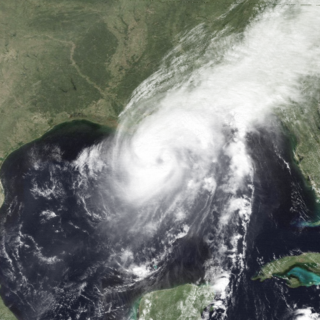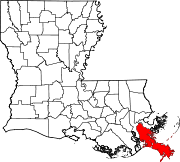
Plaquemines Parish is a parish located in the U.S. state of Louisiana. With a population of 23,515 at the 2020 census, the parish seat is Pointe à la Hache and the largest community is Belle Chasse. The parish was formed in 1807.

Pilottown is an unincorporated community in Plaquemines Parish, Louisiana, United States. It serves as a base for river pilots to guide ships across the bar and up and down the Mississippi River. As of 2020, the population of the community is 0.

Jacques Élisée Reclus was a French geographer, writer and anarchist. He produced his 19-volume masterwork, La Nouvelle Géographie universelle, la terre et les hommes, over a period of nearly 20 years (1875–1894). In 1892 he was awarded the Gold Medal of the Paris Geographical Society for this work, despite having been banished from France because of his political activism.

Pointe à la Hache is a census-designated place (CDP) and unincorporated community in Plaquemines Parish, Louisiana, United States. Located on the east bank of the Mississippi River, the village has been the seat for Plaquemines Parish since the formation of the parish. As of the 2020 census, its population was 183, less than half its 1930 population. It suffered severe damage from Hurricane Katrina in 2005 and Tropical Storm Lee in 2011.

Louisiana or French Louisiana was an administrative district of New France. In 1682 French explorer René-Robert Cavelier, Sieur de la Salle erected a cross near the mouth of the Mississippi River and claimed the whole of the drainage basin of the Mississippi River in the name of King Louis XIV, naming it "Louisiana". This land area stretched from the Great Lakes to the Gulf of Mexico and from the Appalachian Mountains to the Rocky Mountains. The area was under French control from 1682 to 1762 and in part from 1801 (nominally) to 1803.

The Mississippi River Delta is the confluence of the Mississippi River with the Gulf of Mexico in Louisiana, southeastern United States. The river delta is a three-million-acre area of land that stretches from Vermilion Bay on the west, to the Chandeleur Islands in the east, on Louisiana's southeastern coast. It is part of the Gulf of Mexico and the Louisiana coastal plain, one of the largest areas of coastal wetlands in the United States. The Mississippi River Delta is the 7th largest river delta on Earth (USGS) and is an important coastal region for the United States, containing more than 2.7 million acres of coastal wetlands and 37% of the estuarine marsh in the conterminous U.S. The coastal area is the nation's largest drainage basin and drains about 41% of the contiguous United States into the Gulf of Mexico at an average rate of 470,000 cubic feet per second.

Last Island was a barrier island and location of a pleasure resort southwest of New Orleans on the Gulf Coast of Louisiana, United States. Located south of Dulac, Louisiana, between Lake Pelto, Caillou Bay, and the Gulf of Mexico, it was named Last Island because it was the last of a series of barrier islands which stretched westward from the mouth of the Mississippi River, 90 miles to the east.

The Chandeleur Islands are a chain of uninhabited barrier islands approximately 50 miles (80 km) long, located in the Gulf of Mexico, marking the outer boundary of the Chandeleur Sound. They form the easternmost point of the state of Louisiana, United States and are a part of the Breton National Wildlife Refuge. They are an important migrating point for many birds on their way south, and are a prime marsh and forest wildlife area.
A Mississippi River Pilot is responsible for guiding ships along the Mississippi River, including across the bar from the Gulf of Mexico, through the shifting sandbars and passages at the mouth, and upriver to New Orleans and Baton Rouge.

Ship Island is a barrier island off the Gulf Coast of Mississippi, one of the Mississippi–Alabama barrier islands. Hurricane Camille split the island into two separate islands in 1969. In early 2019, the US Army Corps of Engineers completed the first stage of a project rejoining the two islands and recreating one Ship Island. Ship Island is the site of Fort Massachusetts, as a Third System fortification. Part of the island is included in the Gulf Islands National Seashore.

Tropical Storm Frances caused extensive flooding in Mexico and Texas in September 1998. The sixth tropical cyclone and sixth named storm of the annual hurricane season, Frances developed from a low pressure area in the Gulf of Mexico on September 8. The cyclone moved northward through the western Gulf of Mexico, making landfall across the central Texas coastline before recurving across the Midwest through southeast Canada and New England. A large tropical cyclone for the Atlantic basin, yet an average sized system by western Pacific standards, the storm produced heavy rains across the Isthmus of Tehuantepec, Texas, western Louisiana and the Great Plains.

Hurricane Florence was the third of four named tropical cyclones to make landfall on the United States during the 1988 Atlantic hurricane season. The seventh tropical storm and second hurricane of the season, Florence developed on September 7 from an area of convection associated with a dissipating frontal trough in the southern Gulf of Mexico. After initially moving eastward, the storm turned northward and strengthened. Florence reached hurricane status and later peak winds of 80 mph (130 km/h) on September 9 shortly before striking southeastern Louisiana. The storm rapidly weakened over land and dissipated on September 11 over northeastern Texas.

Natchez has been the name of several steamboats, and four naval vessels, each named after the city of Natchez, Mississippi or the Natchez people. The current one has been in operation since 1975. The previous Natchez were all operated in the nineteenth century, most by Captain Thomas P. Leathers. Each of the steamboats since Leathers' first had as its ensign a cotton bale between its stacks.
USS Avenger was a large steamer with powerful guns acquired by the Union Navy during the American Civil War. She was used by the Union Navy as a gunboat in support of the Union Navy blockade of Confederate waterways. Because of her large size, she was also used, at times, as a cargo ship.

The 1812 Louisiana Hurricane was a major hurricane that struck New Orleans, Louisiana, during the War of 1812. It was the worst storm of the early history of New Orleans and was very likely the hurricane which made the closest landfall known to affect the city.

Burrwood was a community located near the far south end of the delta of the Mississippi River in Plaquemines Parish, Louisiana, United States. At one time the town had an estimated population of 1,000, but today it is uninhabited, with most of its territory fully or partially submerged by coastal erosion.

The 1860 Atlantic hurricane season featured three severe hurricanes that struck Louisiana and the Gulf Coast of the United States within a period of seven weeks. The season effectively began on August 8 with the formation of a tropical cyclone in the eastern Gulf of Mexico, and produced seven known tropical storms and hurricanes until the dissipation of the last known system on October 24. Six of the seven storms were strong enough to be considered hurricanes on the modern-day Saffir–Simpson Hurricane Scale, of which four attained Category 2 status and one attained Category 3 major hurricane strength. The first hurricane was the strongest in both winds and pressure, with peak winds of 125 miles per hour (201 km/h) and a barometric pressure of 950 millibars (28 inHg). Until contemporary reanalysis discovered four previously unknown tropical cyclones that did not affect land, only three hurricanes were known to have existed; all three made landfall in Louisiana, causing severe damage.

Adrien de Pauger was the French engineer and cartographer who designed the streets of the Vieux Carre, today known as the "French Quarter", and drew the original map of the city that became New Orleans, Louisiana. De Pauger was appointed in 1720 by Jean-Baptiste Le Moyne de Bienville to draw up the plans for the new city. De Pauger arrived in the settlement on March 29, 1721. The plan was completed later in 1721, which was a significant step to establishing permanence in the French settlement. De Pauger also selected many of the street names such as Bourbon Street and Royal Street as well as others. This street plan is still in place today. Working with Bienville's chief engineer Pierre Le Blond de La Tour, they impressed slave labor to construct the settlement making use of water-resistant cypress wood for raised cottage construction. Slaves under de Pauger labored under the rules of Code Noir, which defined the conditions of slaves in the French Colonial Empire.

The 1901 Louisiana hurricane was the first hurricane to make landfall in Louisiana in the month of August or earlier since 1888. The fourth tropical cyclone and second hurricane of the season, this storm developed southwest of the Azores on August 2. Moving southwestward and later westward, the depression remained weak for several days, until strengthening into a tropical storm while approaching the Bahamas early on August 9. It then crossed through the islands and intensified only slightly. Late on August 10, the storm made landfall near Deerfield Beach, Florida. After reaching the Gulf of Mexico the next day, continuous intensifying occurred and by August 12, the storm reached hurricane status. Peaking with winds of 90 mph (145 km/h), it struck Louisiana late on August 14 and then Mississippi less than 24 hours later. The system weakened to a tropical storm early on August 16 and became extratropical several hours later.




















